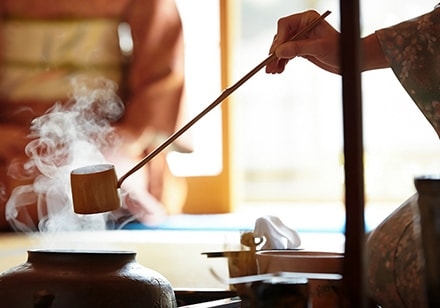TECH & CULTURE
Tea Ceremony
April 14, 2023
Few aspects of Japanese culture are as iconic as a tea ceremony, or sado (茶道). A group of people sitting in a kneeling posture in a tatami room, one person serving and each guest receiving, all done with a precise series of carefully choreographed movements. But what does all of it mean? And where did it come from?

Tea was first introduced to Japan in the 8th century, by way of China. Today it is grown throughout much of the southern half of Japan. It was initially drunk as a medicinal beverage, mainly by the nobility and the priesthood, but as cultivation spread it was eventually enjoyed by all social classes. Early tea ceremonies were primarily social entertainment in which participants would show off their expensive cups and utensils, as well as their knowledge about tea.
By the 15th century, practitioners of Zen Buddhism had begun to adopt tea drinking as a spiritual practice, in which the process of pouring, serving, and consuming the tea were intended to focus one’s understanding. The 16th-century tea master Sen no Rikyu developed and refined the styles of tea ceremony in ways that still carry influence today. The central concept of his approach was “ichi-go ichi-e” (“one time, one meeting”), meaning that each moment in life is unrepeatable, even by the same people gathering in the same place, and therefore must be respected and cherished as a once-in-a-lifetime experience.
A modern formal tea ceremony can last up to four hours, depending on the season and the number of guests. After arriving in the tea room, each guest sits in an assigned place. The host serves the first guest, who must admire the bowl, then after taking a sip, wipe the rim clean before passing it to the next guest, who does the same. The precise order of actions, the placement of each of the utensils, the arrangement of the guests and host, and many other elements will depend on the styles of the particular school of sado.
By the 15th century, practitioners of Zen Buddhism had begun to adopt tea drinking as a spiritual practice, in which the process of pouring, serving, and consuming the tea were intended to focus one’s understanding. The 16th-century tea master Sen no Rikyu developed and refined the styles of tea ceremony in ways that still carry influence today. The central concept of his approach was “ichi-go ichi-e” (“one time, one meeting”), meaning that each moment in life is unrepeatable, even by the same people gathering in the same place, and therefore must be respected and cherished as a once-in-a-lifetime experience.
A modern formal tea ceremony can last up to four hours, depending on the season and the number of guests. After arriving in the tea room, each guest sits in an assigned place. The host serves the first guest, who must admire the bowl, then after taking a sip, wipe the rim clean before passing it to the next guest, who does the same. The precise order of actions, the placement of each of the utensils, the arrangement of the guests and host, and many other elements will depend on the styles of the particular school of sado.


